Croatia faced France in another World Cup final replay, only this time, the two titans faced off in the UEFA Nations League. And once again, just like in their previous encounters, Didier Deschamps’ team managed to overcome Zlatko Dalić’s.
But despite the 2-1 scoreline pointing towards another France outplay, Croatia were more than worthy opponents for the world champions. This tactical analysis will dissect both teams’ tactics and identify their main approaches.
Lineups
For Dalić, there weren’t really that many surprises in the squad. Croatia lined up in their standard 4-2-3-1 positions with Dominik Livaković between the sticks and a four-man defence consisting out of Filip Uremović, Dejan Lovren, Domagoj Vida and Borna Barišić.
Luka Modrić and Milan Badelj were deployed in a double-pivot while Nikola Vlašić had a free role just ahead of them. Ivan Perišić and Mario Pašalić were wide midfielders while Bruno Petković was alone up top in the centre-forward role.
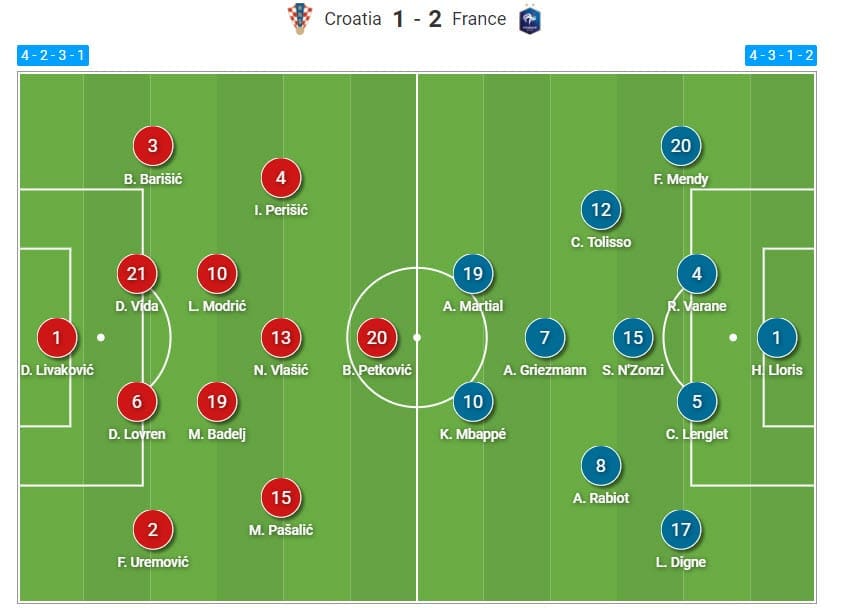
Deschamps went with a 4-3-1-2 formation with some changes but also with familiar faces. Hugo Lloris was in goal and protected by a backline of Ferland Mendy, Raphaël Varane, Clément Lenglet and Lucas Digne.
In midfield, Corentin Tolisso partnered Steven N’Zonzi and Adrien Rabiot. The forward line was made up of Antoine Griezmann in the no.10 role and Kylian Mbappé and Anthony Martial just ahead of him.
France in possession and positional dismarking
Even though Deschamps initially set his team up in a 4-3-1-2 system, that was rarely the case throughout the match. In possession, France would usually drop one of the midfielders, primarily N’Zonzi, in the backline to create a three-man defence. This wasn’t always necessary because Croatia preferred a defensive setup with only one player up top for the majority of the time.
However, it still served the purpose once the press from the opposition was triggered. Below, you can see a graphic depicting the relationship between France’s attacking system and Croatia’s defensive one.
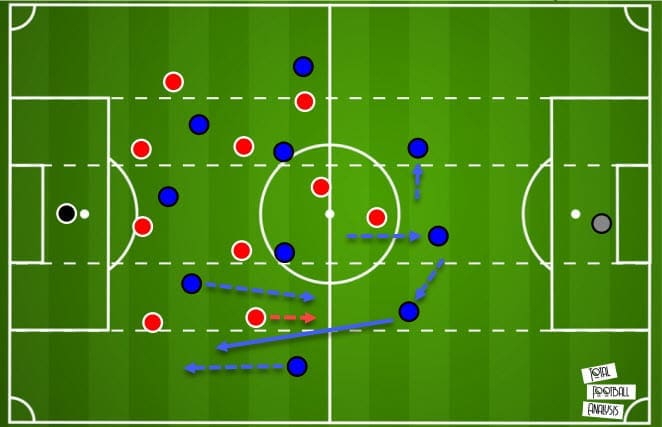
An important thing to note about Croatia and their defending was that it was rarely a stable system. The players moved in a reactionary manner, depending on the movement of the opposition. Above, you can see them defend in a variation of a 4-2-3-1 but they would swap between that, the 4-1-4-1 and even 5-2-3.
The pattern highlighted in the analysis above shows us a very recurring play for France on the night. N’Zonzi drops to make a back three and this allows Digne to push forward. With Croatia mostly defending with one man up top and applying minimal pressure, this made the ball progression in the first phase very easy. Below, we can see a pattern similar to the one depicted in the graph.
Mbappé drops deeper, which drags one of Croatia’s midfielders with him, leaving Digne to advance in a 1v1 situation with the opposite full-back.
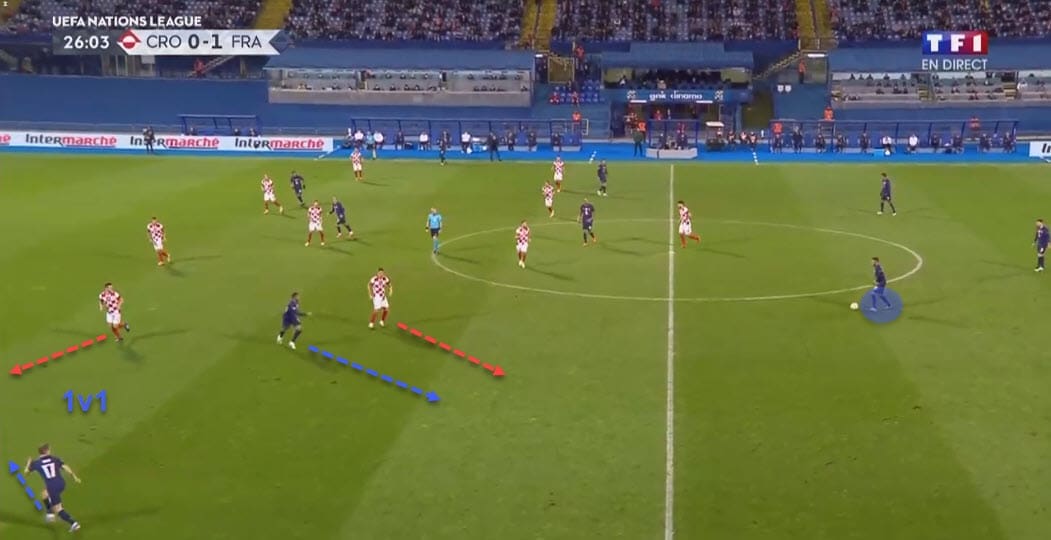
This was France’s main way of progression and it all started from the centre-backs who were given far too much time and space to play through balls into the danger area. Both Varane and Lenglet are extremely good on the ball and they made use of the opportunities quite well.
Let’s observe a couple more examples that showcase this perfectly. Below, with France again having numerical superiority in the first phase, they easily recycle the ball across the backline and Varane can run with it forward.
Once he steps up, the press is activated but at that point, it’s already too late. Real Madrid’s centre-back can pierce a ball into the space up front.
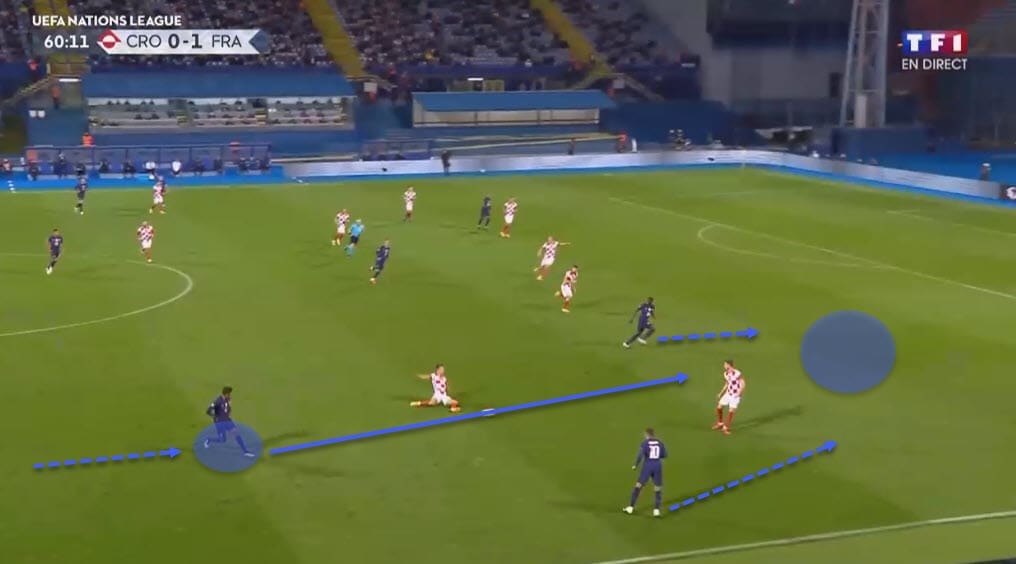
It was on that right side that France really used that connection between the two LaLiga stars as Varane and Mendy often combined. But interestingly, it was always through a very specific pattern that they would exploit the channels.
The following example shows Varane once again stepping up easily and Mendy and Martial swapping places with quick changes of pace to overload Croatia’s left flank. Notice again how only one player is pressing France’s backline, meaning they can easily progress the play.
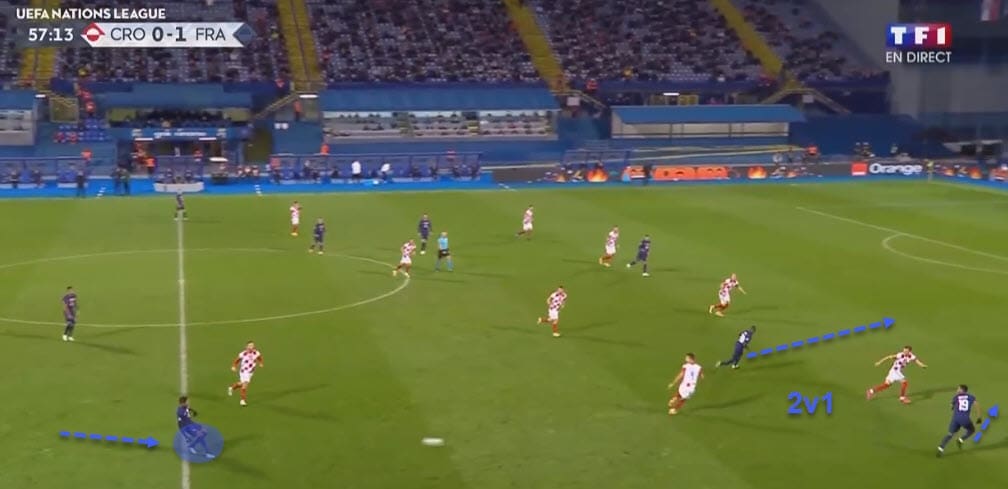
The most common card in Deschamps’ tactics that night was the opposite movement of the winger and the full-back. Once the former drops, the latter immediately overlaps and bursts forward.
We’ve seen it in the first in-game example in this tactical analysis with Mbappé and Everton’s Digne and down below, you can see a similar thing with Mendy and Martial.
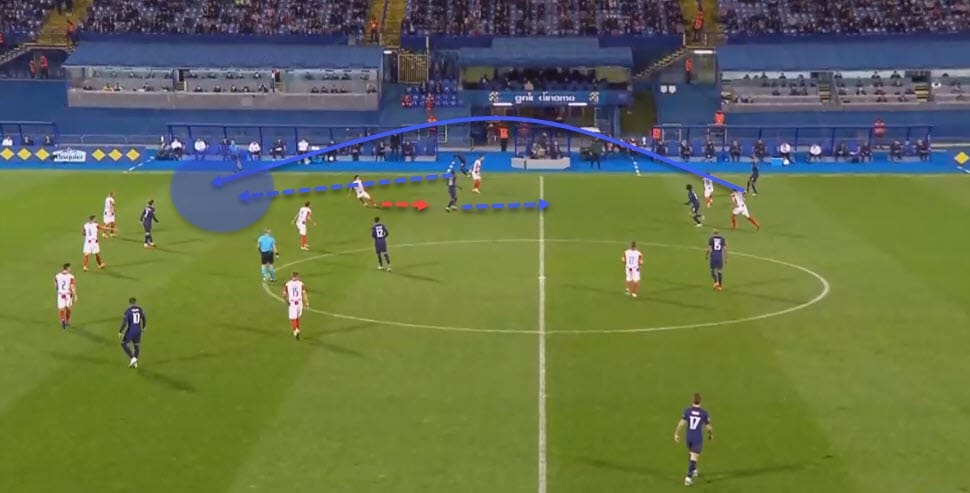
Of course, a lot of that was enabled by Croatia’s unwillingness to press, allowing France’s centre-backs to play the dangerous passes. With 13.5 PPDA (passes allowed per defensive action), Dalić’s players were the more aggressive ones on the night but that figure was as high as 23.8 in the first 45 minutes, which is when France were the more dominant side.
When they did press, however, it didn’t look cohesive enough. The main problem with their defensive structure was that it seemed too disjointed. The midfield and the forward lines were too far apart and this would result in France progressing easily despite being pressed.
This was especially true when the pivot of the 4-2-3-1 system would be left behind as rest defence when the team was trying to press aggressively. We can see an example of that below as France easily recycle the ball and establish numerical superiority to escape the press.
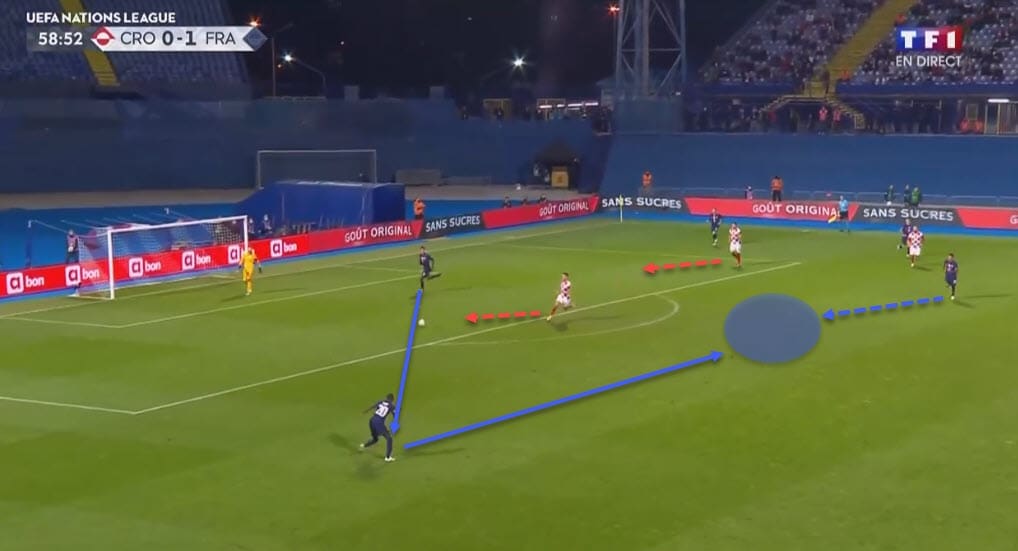
Of course, if France decided to drop their midfielders to support the backline, this would activate Croatia to press with their midfielders as well. But once again, on those occasions, the pressing tactics didn’t look clean and often resulted in giving up acres of space for the opposition.
Below, Modrić is chasing up Rabiot but with a heavily disjointed pressing squad, France easily outplay the move and advance the ball.
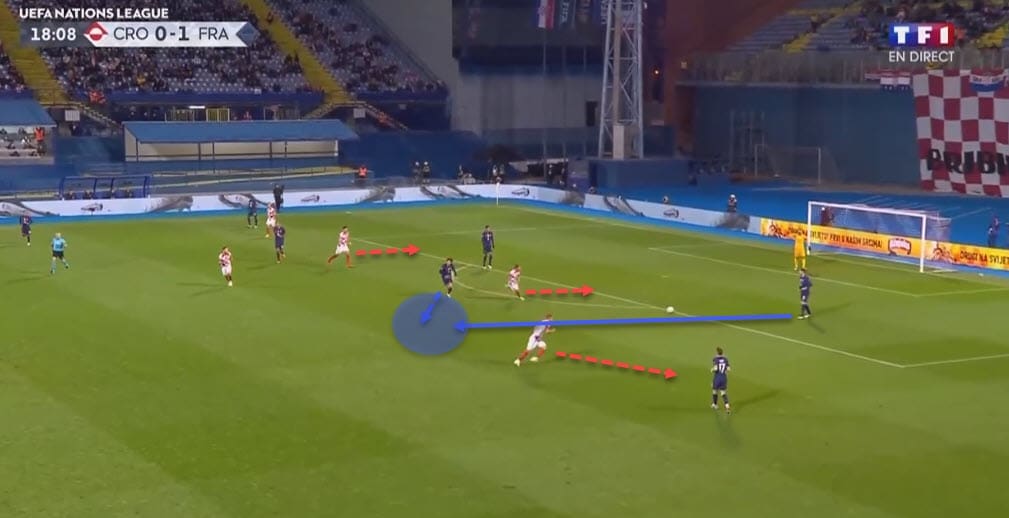
Our tactical analysis will now turn to Croatia and how they looked to threaten Lloris’ goal.
Croatia in possession and wide overloads
Croatia were the more consistent of the two when it comes to respecting the initial system. The 4-2-3-1 translated well onto the pitch and was largely visible in all phases of play for Dalić and his troops. Even though they couldn’t threaten France too much in the first half, they did well to overcome their defensive shape in the first phases of attack.
Below, you can see a graphic that shows us the interaction between their attacking 4-2-3-1 and France’s defensive 4-3-3. Just like Croatia, France also swapped through different defensive approaches.
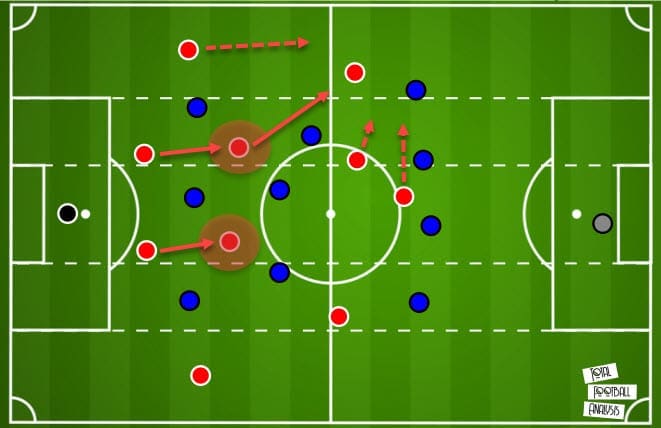
During a higher press, they maintained the 4-3-3 and would then drop into a 4-4-2 diamond in the middle third with Griezmann at the tip and then finally, to a 4-4-2 flat deeper on the pitch with Barcelona’s forward joining the midfield line.
With 27.8 PPDA on average across both halves, France were certainly not overly aggressive in their pressing. Even though with a front three they could outnumber Croatia’s centre-backs, progressing the ball was easy for Vida and Lovren. The graph above depicts one of their more common tactics from the game.
The double-pivot of Modrić and Badelj would position themselves in half-spaces so the centre-back duo could easily find them with passes to advance the play. You can see such an example in the following image.
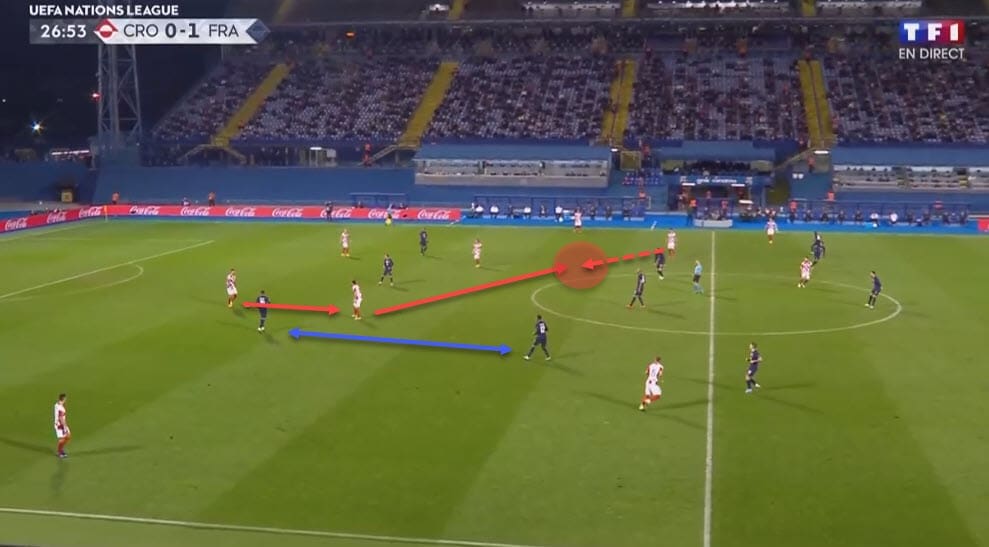
Here, the midfielder can easily receive the ball, turn and then progress it forward in just a couple of touches. Part of the problem for France was that they were not vertically nor horizontally compact enough on most occasions, as you can see above too.
Deschamps tried tweaking his tactics a bit so the midfield line would push up at times to potentially stifle the build-up phase. N’Zonzi and Tolisso would press Croatia’s double-pivot while Rabiot kept the no.10 in his cover-shadow.
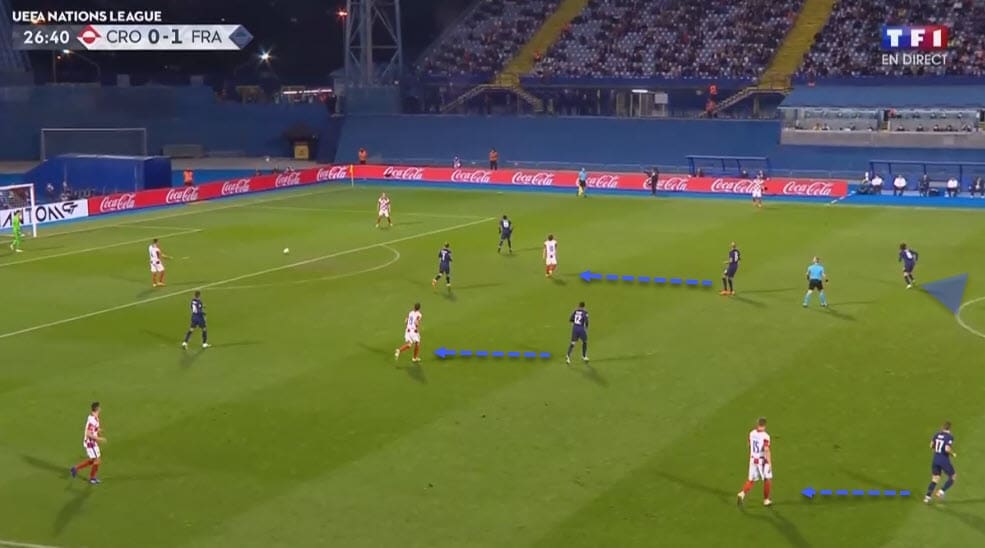
Once the ball is then recycled directly towards the full-backs, they start moving to the flanks and you can see Rabiot do that above as well. Alternatively, it were the forwards who tried keeping the pivots in their cover-shadow so that the midfielders can keep track of their counterparts, potentially deeper on the pitch.
Such an example can be seen down below as Griezmann and Martial mark Badelj and Modrić so Rabiot and Tolisso can pick other targets out wide.
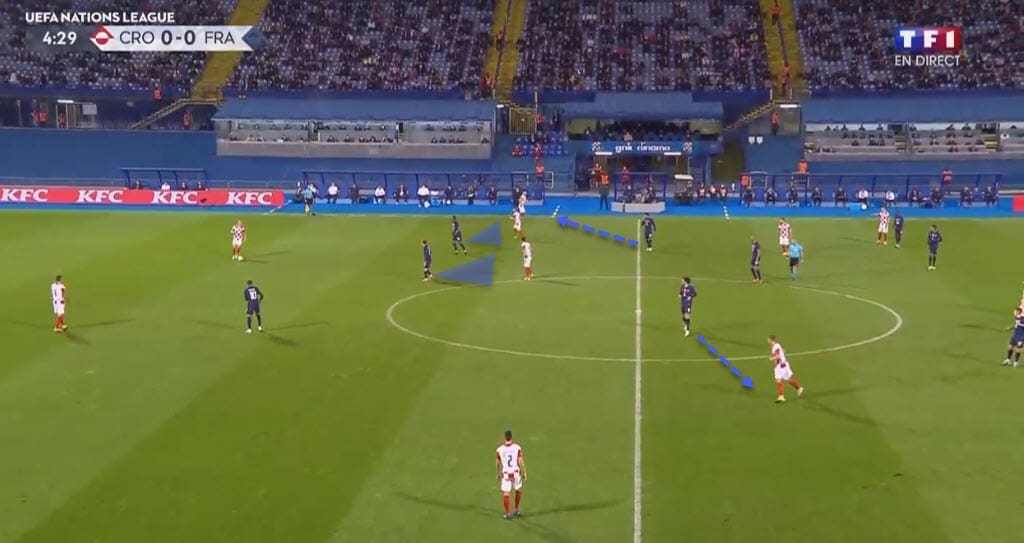
But going back to Croatia and their attacking tactics, the initial graphic in this section of the tactical analysis showed that they tended to move towards the flanks often. Interestingly, they didn’t seem to attack much through the centre despite now having Petković as the centre-forward.
The combinations would mostly revolve around creating superiorities out wide and then forcing a cross into the box or quickly swapping the play to the weak side. Below, we can see their attempts to overload the left flank with both the attacking midfielder and the striker drifting wide.
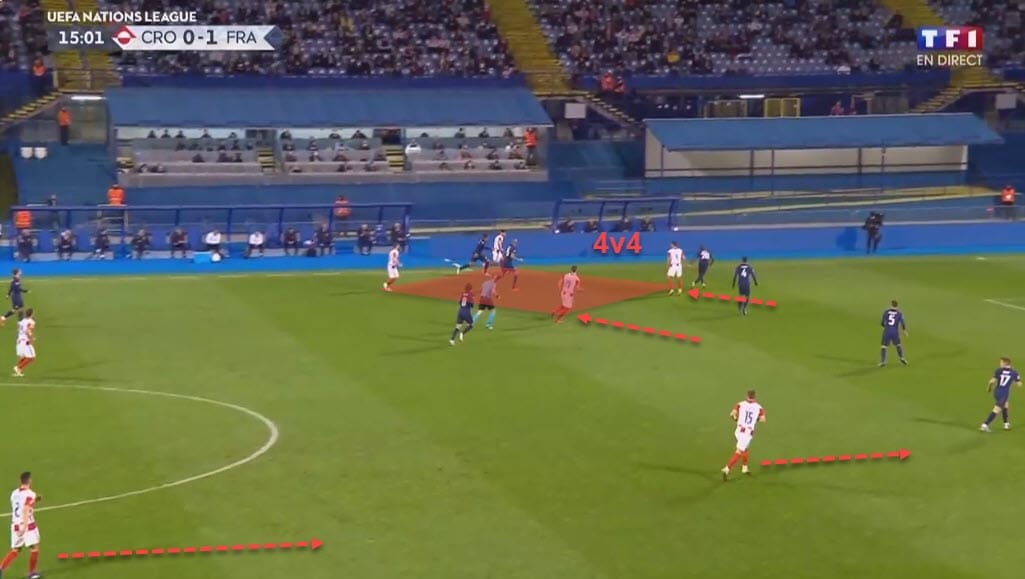
I’ve also highlighted the players on the other side already making a run towards the box because that is an important aspect of their attacking tactics. Often, the man on the ball would cut inside or play it towards one of the midfielders who can switch play really quickly.
That way, with most of France’s defence on one side, they can guarantee a favourable situation on the other one. Usually, that would create 1v1s, 2v1s or 2v2s, all of which would be good odds for the team on the ball.
Below, we can Perišić cutting inside and then quickly sending the ball across where a 2v1 situation can be created.
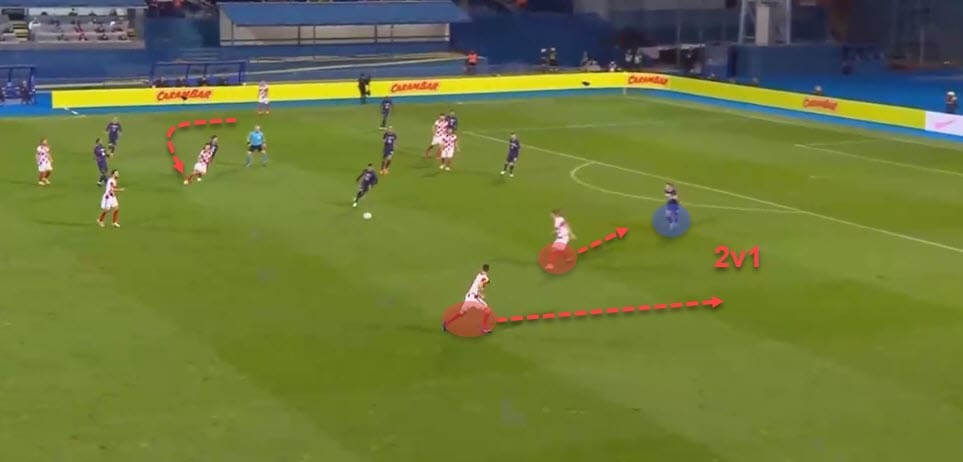
Croatia’s second-half resurgence
With a goal down and unable to breach France’s defence, Dalić didn’t wait too long to make changes to both the personnel and the tactics. The final part of this tactical analysis will briefly touch upon their resurgence in the final 45 minutes of the clash.
Mateo Kovačić replaced Badelj and Chelsea’s midfield maestro quickly took over the game. The tempo upped immensely and Croatia were far more aggressive than they were in the first half, as indicated by the graph below.
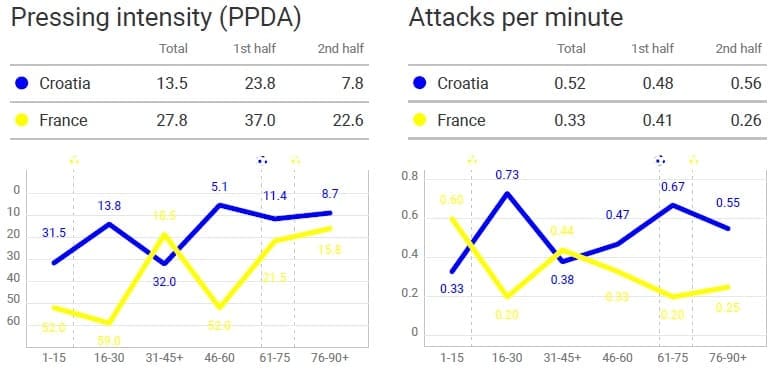
You can see that their PPDA values dropped from 23.8 to 7.8, which is incredible and attacks per minute skyrocketed as well. This resulted in France not having almost any time on the ball and we’ve seen in the previous parts of this tactical analysis how instrumental that was for their attacking tactics.
As a result, they started relying on long balls in-behind the defensive line a lot, which, unfortunately for Croatia, yielded them the winning goal as well. But the introduction of Kovačić deserves a bit more analysis as well.
The young midfielder immediately started dropping into the backline and then using his runs to progress the ball up the pitch. You can see him combining with Modrić in the image down below.
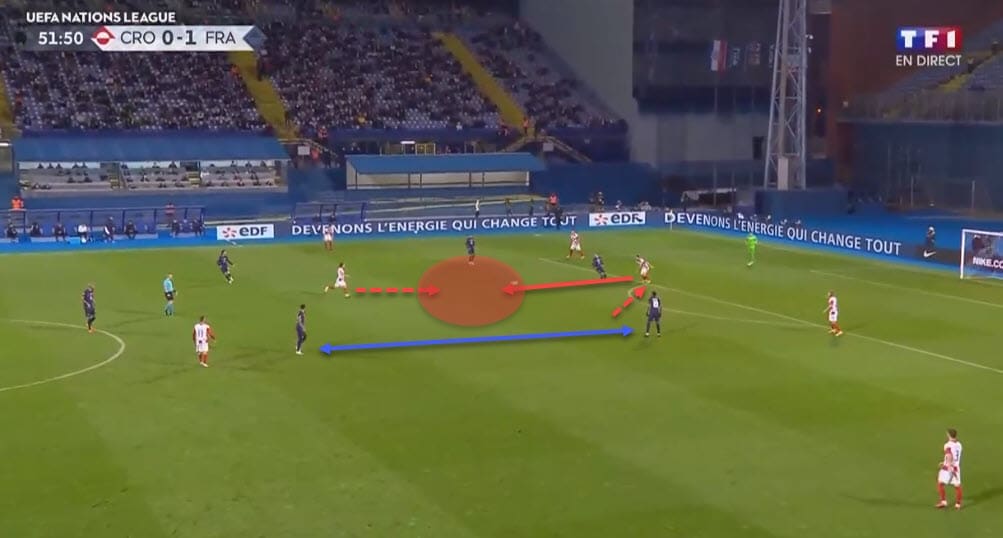
Since Croatia’s centre-backs are not as proficient on the ball nor as progressive in their movement, this variation in the build-up allows the two midfielders to combine easily and move the play forward.
Also, notice the lack of vertical compactness in France’s defensive system, which is something we’ve identified as an issue in their tactics earlier in the analysis. Finally, another example of Modrić and Kovačić combining well to outplay the opposition.
Once again the latter is in the backline while the former shifts over to connect. A swift one-two sees Croatia advance up the pitch and continue the attack.
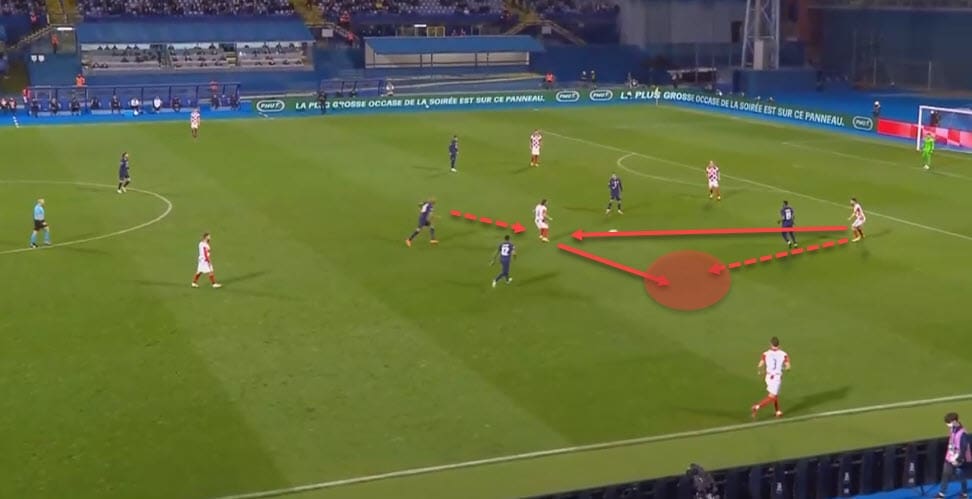
The equalising goal came from Vlašić, another midfielder who gives Croatia something different in the middle of the park. His presence in the box ensures they have more threat and cutting edge going forward but unfortunately for them, it wasn’t to be this time yet again.
Dalić’s team was in control for the majority of the second half but a swift attacking play saw Mbappé seal their fate once more.
Conclusion
Croatia played well and more likely than not, they deserved at least a draw from this clash. However, you can’t allow the champions of the world an opportunity to strike because they will most certainly take it.
Still, the game was an interesting case study with two giants colliding and hopefully made for an entertaining tactical analysis.






Comments